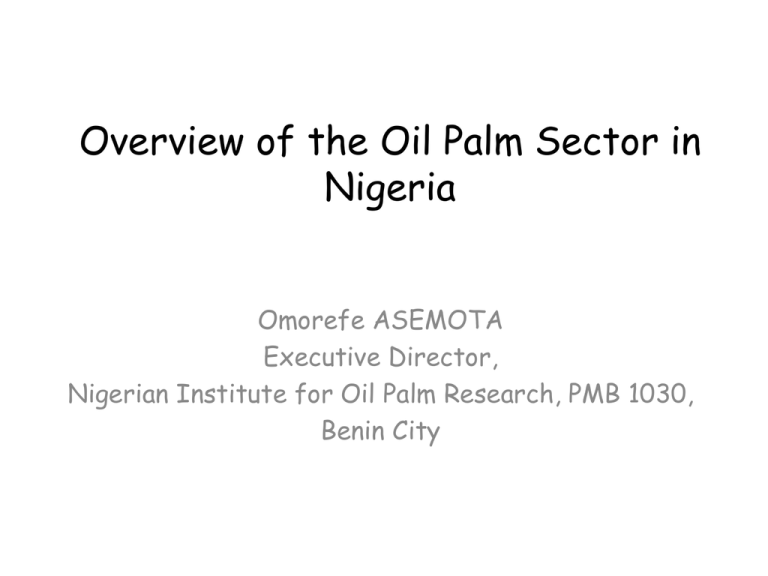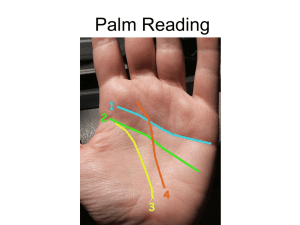Overview of the Oil Palm Sector
advertisement

Overview of the Oil Palm Sector in Nigeria Omorefe ASEMOTA Executive Director, Nigerian Institute for Oil Palm Research, PMB 1030, Benin City Oil palm – Enough space for attention away from to crude oil obsession Source: Cartoon from The Vanguard 20th November 2014 Possible income using improved planting materials ( assume extraction rate 20%) Un-improved materials 3–5 NIFOR tenera hybrid 15 – 25 Oil yield tonnes ha-1 0.5 – 1 3–5 FFB income (N ha-1) 60, - 100,000 300 – 600,000 Oil income (N ha-1) 100, - 200,000 600, - 1,000,000 Yield (FFB) tonne ha-1 yr-1 E PALM OIL UTILIZATION CHART Value chain of the oil palm from fruit bunch to downstream Fresh fruit bunch Mill process Palm kernel Empty bunches & Palm oil mill effluent Palm kernel shell Palm fatty acid Palm fatty acid Crude palm oil Refining & Fractionation RBD Olein Palm mid fraction Compounding Biogas, Fuel briquettes, Animal feeds, fertilizer RBD Stearin Shortening Fatty alcohols Fatty amines Fatty amides Frying Cooking Shortening Margarines Blending Margarine Ice cream Cocoa butter equivalent Filled milk Biscuit cream The Oil Palm & Economic Development The golden days of the industry • Export duty and oil palm produce sales tax revenues provided the bulk of the internally generated revenue • The major source of revenue for the economic development of the defunct Eastern Region of Nigeria. • Employment: - about 3,700,000 persons or 70% of the 5,250,000 agricultural workforce of the adult working population of 6,596,000 (of the 1962/63 census) of Eastern Region in 1963 were involved in the processing of oil palm products for exports (Usoro, 1974) • Currently, across the oil palm producing states, an estimated 5 million Nigerians are directly involved in oil palm cultivation and processing (Omoti, 2009, 2012). High capacity to create employment and wealth - from planting materials to the field to the mill to the market. The Oil Palm & Economic Development- Now • Provides direct and indirect employment to many Nigerians in related activities such as contracting, supplying, trading, transporting and manufacturing etc. • Gross value of the palm oil production at plantation level by the industry at current domestic prices c. N180-N250 billion annually • Still very significant in terms of the Agricultural GDP of the country. • The industry has transformed in sophisticated dimensions globally with diversification of utility of palm produce • Global value of palm oil is about USD 50Billion The Oil Palm & Economic Development • Industry is still unsophisticated in Nigeria with dominance of small inefficient producers across the value chain • In Nigeria, the climatic and soil conditions of the Niger Delta best support the oil palm. • It is widely exploited both in the wild groves which abound in the region and in the cultivated state in small and large plantations. • The region accounts for a very significant fraction of oil palm production in Nigeria (Table 2) • Almost all of the large estates and about 84% of small holdings are located in the Niger Delta States • The oil palm need to be harnessed to again become a very significant sector of the national economy providing the wealth for economic development and the much needed jobs for Nigeria’s teeming population. Table 1. Example of Wealth creation e.g. 8,000 ha oil palm plantation at maturity average of 15 years. Adapted from 2012 Annual Report, Okomu Oil Palm Plc Wealth created Turnover (wealth created) N 6,400,000,000 Costs Employees + supplies + contractors 2,500,000,000 Profit Gross Profit before tax Tax (assume) – Federal Government Net Profit 3,900,000,000 500,000,000 3,400,000,000 Benefit to State Employment (direct + indirect) - no 3000 Employees PAYE Taxes ??? Benefit to the Investing Public Dividend per share N7.00 Opportunities for varied Actors Across the gender spectrum • Men, • Women • Youths Palm oil demand in Nigeria • Population growth rate nearly 3% annually = increasing demand • Population in 2014 c. 170m (National Census, NPC) • Palm oil and palm kernel oil account for about 72% of the Nigeria’s total vegetable oil production • Estimated annual demand for palm oil grew by 5% between 2005 and 2012 vs annual growth of 1 – 2% of palm oil production in same period • Implicit in this is a widening supply demand gap • Oil World Statistics (2008) estimated per capita consumption of vegetable oil in Nigeria = 12.7kg vs. global average 17 kg • By current projected population, Nigeria’s annual requirement is about 3m MT of palm oil • With estimated total national vegetable production of about about 1.3 million tonnes (all other vegetable oils inclusive) there is a supply demand gap in excess of 800,000 MT tonnes • Growing market for frying oils with growing fast food and noodles industry • Supply demand gap is partly met from importation and smuggling across the borders Table 2. Estimated Oil Palm Holdings outside the Groves in the Niger Delta States as at 2012 State Estates Small holders 1 Abia 4,589 27,765 2 Akwa Ibom 3,095 32,277 3 Bayelsa 1,083 2,500 4 Cross River 30,670 27,850 5 Delta 6,300 15,000 6 Edo 27,856 26,000 7 Imo 3,410 67,690 8 Ondo 16,169 10,143 9 Rivers 18,300 55,500 Total 111,472 264,725 Total National 119,000 313,000 % of National 93.7 84.6 Source: Computations from Omoti (2009) and Omoti & Ikuenobe 2012 Field surveys Table 3. States of Nigeria suitable for oil palm cultivation Highly suitable Suitable to Marginally suitable 1 Abia Adamawa 2 Akwa Ibom Benue 3 Anambra Ebonyi 4 Bayelsa Kaduna 5 Cross River Kogi 6 Delta Kwara 7 Edo Nassarawa 8 Ekiti Niger 9 Enugu Oyo 10 Imo Plateau 11 Lagos Taraba 12 Ondo FCT 13 Ogun 14 Osun 15 Rivers Challenges of the industry • Land tenure • Low productivity, especially among the dominant small producers • Low adoption of technology and innovations among the small producers • Poor quality produce of and therefore inability to access high niche industrial markets among small producers • Highly capital intensive • Poor access to cheap development capita • Bridging the demand supply gap - reduction in imports • Low re-planting and replacement of moribund plantations • High reliance on the groves by the small holders • Inconsistent policies on tariffs for imported CPO and refined palm oil Opportunities in the value chain to impact production • Improvement in the traditional processing methods and wide scale adoption of more efficient processing methods • Improvement on quality of produce to enable small producers enter the industrial niche market • Massive new plantings involving nucleus estates and small holders and out-growers schemes linked to estates • Investment in down stream processing • Wide scale adoption of improved planting materials • Replanting of old palms using improved materials from advanced breeding lines. Opportunities will anchor on • Synergy of the vibrant small holder systems and large estates to increase the area under cultivation through active development of small holder growers and organizing them as out-growers to the nucleus plantations in the states • Providing incentives for large industrial estate development • Bringing the vast natural groves under improved planting through gradual replacement with improved genetic materials . • This is strategy of providing land for effectively increasing the area under oil palm in the states without compromising the forest and environmental resources of the states. • Enhancing the quality palm produce (palm oil, palm kernel, etc) through efficient milling to meet industrial standards and consequently enhancing marketing. The desired future • Government support to the industry through provision of rural infrastructure and some incentives which build small holders and support to large nucleus estates • Increased area under improved oil palm holdings • Increased productivity among the small holders and small millers through deployment + internalization of improved technologies and reduced cost of production. • Higher activity among producers leading to higher direct and indirect employment, including artisan and welders at the village level • Diversification of the value chain • Higher income for producers and marketers. • Stable , peaceful and prosperous rural sector Thank You








